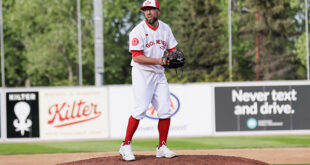
Yankee fans who lived through the late 1970s championships, then the up-and-down and ultimately title-less 1980s remember a familiar phrase: “The Columbus Shuttle.” Burly slugger Steve “Bye-Bye” Balboni may have been its most well-know rider, but the AAA International League entry, which switched to the Yankees in 1979 after serving most recently as the Pirates’ top farm club, was building its own dynasty, going into the 1981 season having won the IL title in each of the first two years under the Pinstripe umbrella.
While the parent club, along with the other Major League squads, halted play midsummer due to the players’ strike, the Clippers sailed on, with a roster full of past and mostly future big leaguers, and a few minor league legends like Marshall Brant, a name that Yankee fans were hearing even back to the Bronx, as perhaps the first baseman of the future there.
In Almost Yankees: The Summer of ’81 and the Greatest Baseball Team You’ve Never Heard Of (Univ. of Nebraska press, 336 pps, $29.95), author J. David Herman looks back at that squad which in many ways epitomized not just baseball in a different time, but also captured a bit of the craziness that was the Yankees and Principal Owner—and Ohio native—George M. Steinbrenner III, a condition that certainly rolled downhill to its AAA affiliate back “home.”
 If names like Balboni, Brant and Brad Gulden are more known to Yankees fans than anyone else, here are a couple more that made up that ’81 Clippers squad: Dave Righetti and Buck Showalter. Of course, the first of those had far more success on the field than the second, but both were part of later dynasties, in and out of pinstripes and on and off the field. And they were all managed by a baseball lifer named Frank Verdi, a colorful figure who in his own way brought it all together.
If names like Balboni, Brant and Brad Gulden are more known to Yankees fans than anyone else, here are a couple more that made up that ’81 Clippers squad: Dave Righetti and Buck Showalter. Of course, the first of those had far more success on the field than the second, but both were part of later dynasties, in and out of pinstripes and on and off the field. And they were all managed by a baseball lifer named Frank Verdi, a colorful figure who in his own way brought it all together.
It’s a roster with a few players who made impacts in the Bronx, but far more whose time in Columbus turned out to be their career highlights, like Paul Boris, Bobby Brown and Tucker Ashford, whether the cause was injury (Lewis), confidence (Brown) or just missing whatever that little extra is that makes for a solid major leaguer (Ashford). Others (Pat Tabler, Andy McGaffigan) were traded, often for members of some of the over-the-hill gang rosters that came up short in the Bronx for the next decade-plus. The stories that Herman unearthed of a team that he loved but that his family had abandoned with mid-season cross-country move are plentiful and paint a picture of what it was like to be thisclose to the majors while alternately enjoying and ruing their existence in Columbus.
But whether they were on the way up like Brown and the star-crossed Andre Robertson or taking one last shot like Mike Bruhert or Dennis Werth, this Clippers squad had the right mix of success and personalities to make for an engaging story, one that Herman weaves, connecting his own experience along with the recollections of dozens of players, and one worthy of discovery by all baseball fans.
 Sports Media Report
Sports Media Report
